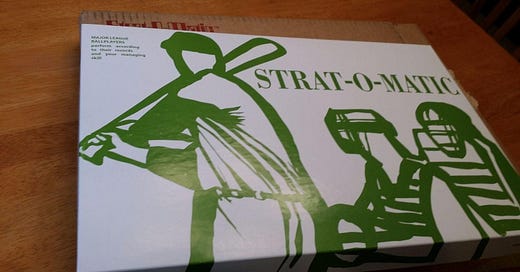Hey Hal — What Gives?
Looking into Hal Richman's original Strat-O-Matic player selection
Hey Hal — What Gives?
We commonly talk about Hal Richman creating an “All-Star” set to accompany the first edition of Strat-O-Matic baseball.
It’s not just something the community came up with, either. In Strat-O-Matic Fanatics, which remains the best book on the history of Strat-O-Matic, Glenn Guzzo describes the original set as containing “eighty players, forty stars each from the American and National Leagues.”
And Richman himself indicated that it these players were All-Stars. This was the first Strat-O-Matic ad, appearing in the April 10, 1961 edition of Sports Illustrated:
Note the wording here: “These All-Stars.”
19 of the 40 American League players that received cards were not All-Stars in 1960. And a whopping 21 of the 40 National League players were not All-Stars in 1960. In other words, 50% of the carded players were not All-Stars.
It’s pretty obvious that Richman intended to choose the best representative players he could from each team. His design was to choose 3 position players and 2 pitchers from each team instead of simply matching the All-Star rosters.
He had good reason to do so, too. It turns out that 1960 was one of those ballot stuffing years. Though the All-Star rosters were expanded in 1960 from 25 players to 30, the teams were a bit lopsided. As described in The Midsummer Classic, still the best book on the history of the All-Star Game:
The final National League roster was dominated with Pittsburgh Pirates, Milwaukee Braves, and Los Angeles Dodgers players. The American League roster was a little bit better balanced, though the Yankees and White Sox dominated.
It’s pretty clear that Richman was hoping that he’d get more support across the country by including an even number of players from every team. However, there were a few decisions he made that seem really odd in retrospect:
Leaving out relief pitchers. Richman only carded starting pitchers. I’m not sure if he was skeptical of the statistical significance of lower innings totals or if there was another reason. Regardless, the original Strat-O-Matic is kind of awkward because you have to use starting pitchers in relief. You’ll also likely have more starting pitchers than you could possibly use.
Only carding 6 catchers. I know Richman was going for big name players, but some of his choices really are a bit odd. Elston Howard wasn’t given a card, likely because Yogi Berra was given a card and Richman couldn’t leave off either Mantle or Maris. Sherm Lollar of the White Sox, however, almost certainly could have received a card. The same goes for Smokey Burgess of the Pirates, who I believe would have been a much better selection than Don Hoak.
Insisting on 5 players per team. Did we really need cards for Jerry Lumpe and Norm Siebern of the Kansas City Athletics, or Hal Smith of the St. Louis Cardinals? If you spend time playing around with the Founder’s Edition, you’ll get a feel for what I’m talking about. There are certain position players that simply make your team worse, players I wouldn’t even trust with a pinch hitting opportunity once in a while.
It’s a shame that Richman didn’t have the capital or the confidence to create full teams in 1961. He created four full teams in 1962, but it wasn’t until 1963 when he was finally able to make 20 players for all 20 Major League teams. And, not coincidentally, 1963 was the year Strat-O-Matic started to make serious money.







Wonder is Hoak is because he needed a third baseman?